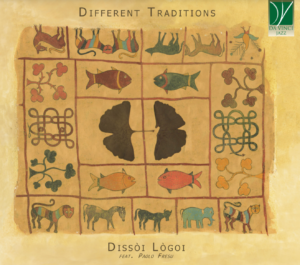
Het nieuwste album van het trio Dissòi Lògoi heet Different Traditions en is een prachtige cross-over tussen de jazz(bigband), Afrikaanse en Indiase muziek.
English version below
Het album Different Traditions van Dissòi Lògoi bestaat uit Part One en Part Two. Respectievelijk voor werken die de afgelopen vier jaar zijn gecomponeerd en werken die zijn geschreven tussen 1979 en 2011. Het trio bestaat uit de drie Italiaanse multi-instrumentalisten Alberto Morelli, Franco Parravicini en Federico Sanesi. Voeg daar nog een dozijn gastmusici aan toe en je hebt een scala aan mogelijkheden. En die volgen ook. Gecomponeerde stukken die zich doelbewust en effectief bewegen op de scheidslijn van eigentijdse jazz- en geïmproviseerde muziek met Afrikaanse en vooral Indiase invloeden.
Instrumenten als de Indiase bansuri (houten dwarsfluit), tabla (kleine trommels) of de met kwarttonen bespeelde viool hebben een heel eigen geluid, een karakteristieke klankkleur. Zodra deze instrumenten worden toegevoegd aan een arrangement, krijgt de muziek direct een Indiaas timbre. Dat geldt ook voor de ritmiek, die in Indiase muziek snel, tot zeer snel kan zijn. Deze snelle ritmiek wordt bijvoorbeeld toegepast in het stuk Delfini, waarin de piano een snel ritmisch patroon speelt, aangevuld met drums in een half-time (dus half zo snel), aangevuld met sarangi (soort Indiase viool, in kwarttonen) en tabla. Het resultaat is een bijzondere mix en een beetje muziek-op-z’n-kop. Wat klinkt hier eigenlijk? Een fascinerende werkwijze die ook te horen in het stuk Dissòi Lògo, waar het orgel een dubbeltempo speelt, gelardeerd met hobo, viool en trompet. Deze uitwisseling van ritmiek en klankkleur is ingenieus gebruikt in de arrangementen en meesterlijk vormgegeven. In het daaropvolgende Pancha Tantra wordt roerig piano- en gitaarspel overgoten met beweeglijk drumwerk en Indiase vocalen. Een oost-westerse dualiteit die wonderschoon uitpakt, al zal het voor de gemiddelde luisteraar wel even wennen zijn. Part Two start met Mentre il Mondo Intorno a Lui Impazzice waarin een steeds herhalende, ostinate (bas)partij ruim wordt omspeeld door sustain-sounds op synthesizer en hobo. Indiase Kelt-folk klinkt er in Alessandrina Inoappennincia, waar het thema wordt gespeeld op de Franse cornemuse en de piffero. Een dubbelriet-instrument uit Noord-Italië, dat klinkt als doedelzak, maar dan zonder bourdon (de lang doorklinkende toon), aangevuld met tabla, drums en elektrische bas. Ja, en zo zit dit album vol met verborgen muzikale heerlijkheden die niet allemaal direct aan de oppervlakte verschijnen en niet altijd even duidelijk zijn. Maar wie de moeite neemt dit album aandachtig te beluisteren (liefst met koptelefoon), zal ze allemaal ontdekken en genieten van deze fantastische, muzikale vrijbuiters!
English version
The latest album of the trio Dissòi Lògoi is called Different Traditions. A beautiful crossover between jazz (big band), African and Indian music.
The album Different Traditions by Dissòi Lògoi consists of Part One and Part Two. Respectively for works composed in the past four years and compositions written between 1979 and 2011. The trio consists of the wonderful Italian musicians Alberto Morelli, Franco Parravicini and Federico Sanesi. These three multi-instrumentalists were assisted by a dozen guest musicians, which gives the orchestra a range of possibilities. And that will come. Composed pieces that purposefully and effectively move on the dividing line between contemporary jazz and improvised music with African and especially Indian influences.
Instruments such as the Indian bansuri (wooden flute), tabla (small drums) or the violin played with quarter notes have their own sound, a characteristic timbre. As soon as these instruments are added to an arrangement, the music immediately takes on an Indian timbre. This also applies to the rhythm, which can be fast to very fast in Indian music. This fast rhythm is applied, for example, in the piece Delfini, in which the piano plays a fast rhythmic pattern, supplemented by drums in a half-time (ie half as fast), supplemented by sarangi (kind of Indian violin, in quarter tones) and tabla. The result is a special mix and a kind of music upside down, in a way. What does this actually sound like? A fascinating method that can also be heard in the piece Dissòi Lògo, where the organ plays a double tempo, interspersed with oboe, violin and trumpet. This exchange of rhythm and timbre is ingeniously used in the arrangements and masterfully combined. In the subsequent Pancha Tantra, turbulent piano and guitar playing is suffused with moving drumming and Indian vocals. An east-western duality that turns out wonderfully. Although it will take some time getting used to, for the average listener. Part Two starts with Mentre il Mondo Intorno a Lui Impazzice in which an ever-repeating, ostinato (bass) part is generously played around by sustain sounds on synthesizer and oboe. Indian Kelt folk can be heard in Alessandrina Inoappennincia, where the theme is played on the French cornemuse and the piffero. A double reed instrument from Northern Italy, that sounds like bagpipes, but without the bourdon (the long resounding tone), supplemented with tabla, drums and electric bass. Yes, and so this album is full of (hidden) musical delights that don’t all immediately show up at the surface and are not always obvious. But whoever takes the time to listen to this album carefully (preferably with headphones), will discover them all and enjoy the music of these great musical freebooters!
- Dissòi Lògoi: Different Traditions (Da Vinci Jazz / Xango)
© Mattie Poels.

Geen reacties